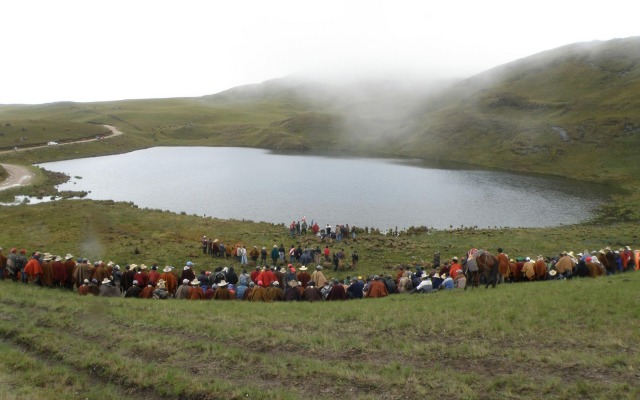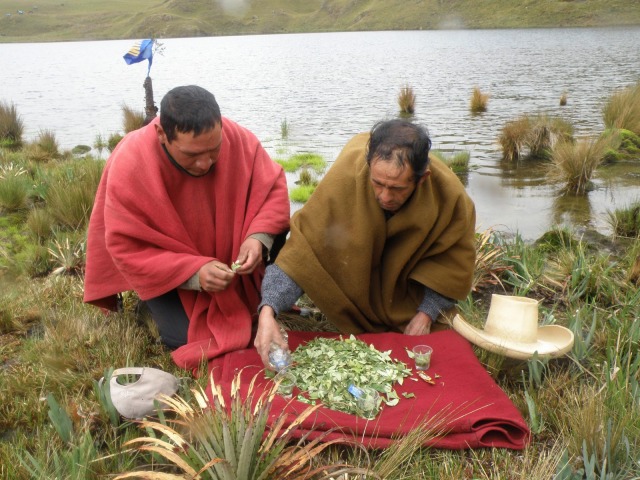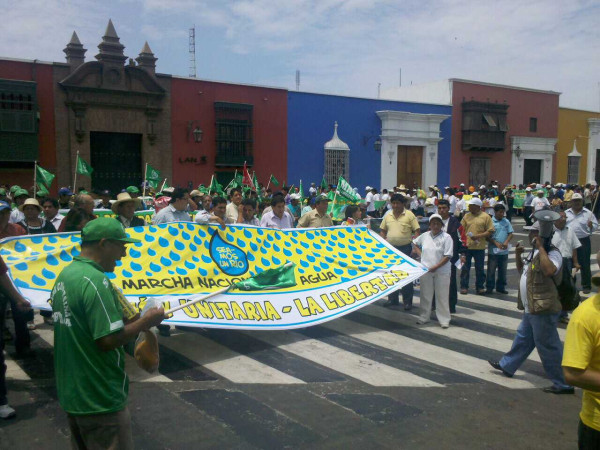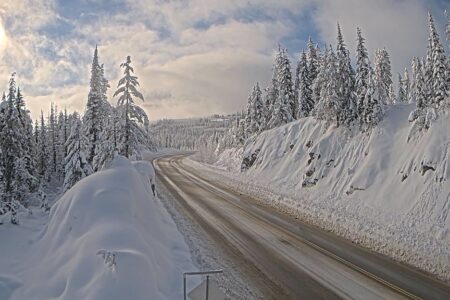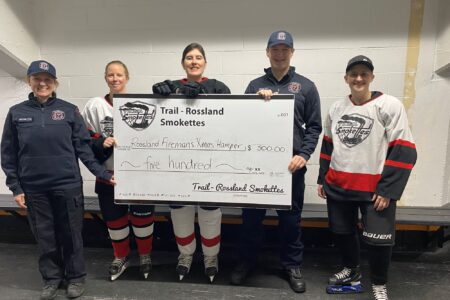It has been 7 days since the Great Water March set off, on February 1, 2012, from the heights of Celendín, Cajamarca, Peru, where the lakes threatened by the Conga [es] mining project are located. The march has unfolded practically without incidents, and is currently halfway to Lima, its final destination.
Meanwhile, the media are reporting on its progress, and publishing editorials [es] on the real purpose of the march, stressing above all its political and ideological affiliations; and government spokespeople declare [es] that in reality “there is an excess of water in Cajamarca”.
The media does not have a standard figure on the number of people who departed from Celendín on February 1. While Terra.pe writes [es] of 200 people, EFE counts [es] 300. Newspaper El Comercio mentions [es] that 600 community landowners started the journey, and RPP indicates [es] that 300 people arrived at Cajamarca's Plaza de Armas to sleep overnight and continue marching the next day.
The blog Seamos un río (Let's be a river) reproduced [es] what was published by Marcio Arana, one of the march's organisers:
Salimos a las 4am, nos reunimos en la plaza de armas de Celendin. Líderes ronderos, mujeres, jóvenes, músicos, maestros, comunicadores, vamos llegando. No hace mucho frio y una suave llovizna nos anuncia que la tierra fértil la está esperando y que los pequeños ríos van a juntarse hasta formar el Gran Rio de Vida que es nuestra Marcha. […]
La noche anterior habían llegado los responsables de barrios trayendo sus aportes económicos para apoyar a los caminantes. Hasta la colecta de profesores, maestros católicos y una niña que en nombre de sus padres dona 20 nuevos soles son aplaudidos. En Lima no faltan políticos que se preguntan quién financia la marcha. Los políticos financiados por grandes grupos de poder económico jamás comprenderán la fuerza y el poder de las pequeñas donaciones como no están entendiendo el gran río que serán los pequeños riachuelos y manantiales.
We left at 4am, and met up in Celendin's Plaza de Armas. Rondero leaders, women, young people, musicians, teachers, communicators, we're arriving. It is not very cold and a light drizzle announces to us that the fertile land is waiting and the small rivers are going to join together to form the Great River of Life that is our March. […]
The night before, neighbourhood leaders had arrived with their economic contributions to support the marchers. Even the contributions from professors, Catholic teachers and a girl who donates 20 nuevos soles are applauded. In Lima there is no shortage of politicians who are wondering who is funding the march. Politicians financed by large, economically powerful groups will never understand the strength and power of small donations, just as they do not understand the great river that small creeks and springs will become.
The first moments of the march were recorded, as can be seen in these videos from users GobRegCajamarca and jampaoli [es]. There were also various statements, like this one from user MetsaRiba who captures the words of a participating campesino:
Or this one showing women from Cajamarca chanting pro-water slogans:
That same day another march took place in Cajamarca, the Jug March [es], where 2,000 people marched in favour of nature and ecology, and protested against polluting mining activities. Servindi published some photos to accompany its report on the solidarity parade held in Lima, which can also be seen on a video uploaded on YouTube [es]. On the blog Celendín Libre (Free Celendín) an itinerary for the first day of the Water March was posted [es], alongside photos of the day's events:
10:30 a.m. Primer obstáculo, una tranquera particular en plena vía pública no deja el pase a ningún vehículo. Los manifestantes proceden a retirarla.
Arribo a la Laguna Cortada (a más de 3 800 m.s.n.m.), donde unas 300 personas dan inicio a la Marcha por el Agua con un rito simbólico de agradecimiento a la mamapacha y mamacocha, por comuneros del Ámaro.
10:30am. First obstacle, a private gate in the middle of the main road is not letting any vehicles past. The protesters proceed to remove it.
Arrival at Laguna Cortada (more than 3,800 metres above sea-level), where some 300 people begin the Water March with a symbolic ritual giving thanks to mamapacha and mamacocha [Incan Goddesses of earth and water], carried out by community land-holders from Ámaro.
In its blog [es], an “International Observation Mission of the Great National March for the Right to Water”[es] publishes information on the march's events, as well as monitoring its peaceful development. There they share the mission's principles and objectives [es] and a list [es] of the entities supporting it. On the first day of the march they commented:
La movilización también ha sido secundada en la región norteña de La Libertad, donde un grupo numeroso de campesinos inició una marcha hacia la ciudad de Trujillo desde las provincias andinas de Huamachuco y Santiago de Chuco.
En Lima, unas 300 personas, en su mayoría jóvenes y dirigentes estudiantiles, realizaron un Pasacalle para celebrar el arranque de la Marcha que culminó en la Plaza San Martín.
The mobilisation has also received support in the Northern region of La Libertad, where a large group of campesinos began a march towards the city of Trujillo from the Andean provinces of Huamachuco and Santiago de Chuco.
In Lima, about 300 people, mainly young people and student leaders, held a street parade to celebrate the start of the March which culminated in the Plaza San Martín.
The next day, the second of the march, participants from Celendín, Bambamarca and other towns departed [es] Cajamarca for Ciudad de Dios in La Libertad, where they spent the night, though not before passing through Choropampa. This is a town where in the year 2000 about 151 kg of mercury belonging to the Yanacocha mine were spilled, greatly affecting the local population. The Observation Mission reported on this day in their blog [es]. Videos [es] of the departure [es] from Cajamarca in the morning have also been uploaded to the internet.
On the third day the marchers left Ciudad de Dios, passed [es] through Pacasmayo and arrived [es] in Trujillo, where they were joined by other delegations from various towns in the La Libertad region, in numbers estimated at around 2,000 [es]. These delegations were greeted by about 5,000 people, and then a rally was held, which included discussion sessions, the presentation of petitions, and other activities as planned [es].
In a post [es] on the blog “El Maletero” “Red Verde Cajamarca” (”The Trunk” “Cajamarca Green Network”) photos from the first three days of the march can be seen. Meanwhile the blog Frente de Defensa Ambiental de Cajamarca (”Cajamarca Environmental Defense Front”) shares more photos [es] of the day in Trujillo. A post on the blog ¡Conga no va! (”Conga will not happen!”) links to a set of photos on Flickr taken in Trujillo.
Twitpic user @YoDash posted some photos of the protest in Trujillo's Plaza de Armas, like this one:
Meanwhile, on Facebook the Water March's page reports [es] that in Trujillo defamatory flyers [es] were distributed, attempting to link the March and its organisers with terrorist movements. In spite of this, the protest continued in the Plaza de Armas until night time with various musical numbers, some of them related to the march and surrounding circumstances, as can be seen in this video posted on YouTube by user Fuzzerjoga:
In the Observation Mission's daily report [es] they note some incidents during a strike carried out in Huarmey:
La Comisión Nacional Organizadora de la Gran Marcha Nacional del Agua ha reportado y denuncia una acción represiva por parte de efectivos policiales. El jueves en la noche, en Huarmey, uno de los puntos de concentración previstos en la Marcha, se produjeron enfrentamientos entre la policía y la población en el marco de un paro de 48 horas contra la minera Antamina, a la que acusan de contaminar el acuífero que les provee de agua potable.
On the fourth day of the march, Saturday 4, the protesters stayed in Trujillo to rest, but they also continued holding discussions and making contact with the local population. On Sunday 5, the fifth day of the march, the group left [es] for the city of Chimbote. The Water March's Facebook page uploaded a video [es] of their arrival in the village of Santa, just before Chimbote. Once in the city they met [es] with the Fisherman's Union, and then left for the city of Casma, following the route South towards Lima.
Meanwhile the Observation Mission's fourth report [es] stresses the government's attitude towards the problem of mining companies and water, bringing together various statements and declarations, including:
– El pronunciamiento del Colegio de Ingenieros del Perú, señalando que: “El Gobierno Peruano, desde la época republicana y hasta la fecha, no tiene una visión de desarrollo sostenido, ya que ha cimentado gran parte de su crecimiento en la explotación minera”.
– El presidente Ollanta Humala señaló que “ningún proyecto se paralizará por la consulta previa, y que esto no es un pretexto para que se detenga la inversión”, en referencia a la falta de la reglamentación de la ley que debía estar lista en diciembre pasado. En agosto del año pasado, sin embargo, el propio presidente escribía en twitter: “El derecho a la consulta previa sobre del desarrollo de los pueblos indígenas es un signo más de inclusión social. Forjamos un Perú para todos”
En este contexto, parecen razonables las palabras de Emma Gómez, de Cooperacción: “hay una lectura equivocada del presidente Humala sobre la Consulta Previa, la cual está siendo considerada como un obstáculo para la inversión privada más que un imperativo para que las empresas extractivas cumplan con los estándares ambientales y sociales de una inversión seria y que respeten los derechos de las poblaciones en las zonas de influencia”.
– The statement from the Engineering Association of Peru, indicating that: “The Peruvian Government, from the first Republican era until today, has never had a vision of sustained development, given that a large part of its growth has been based on mining.”
– President Ollanta Humala indicated that “no project will be paralised by prior consultation, and that it is not a pretext to halt investment”, in reference to the lack of regulations governing the implementation of the law, that should have been ready last December. In August last year, however, the President himself wrote on Twitter: “The right to prior consultation on the development of indigenous communities is a sign of greater social inclusion. Let's create a Peru for everyone”
In this context, the words of Emma Gómez from Cooperacción seem reasonable: “President Humala is misreading Prior Consultation, which is being considered as an obstacle to private investment rather than an imperative for extractive companies to meet the environmental and social standards of serious investment and to respect the rights of the people in affected areas.”
By Juan Arellano in Global Voices.


